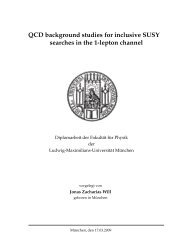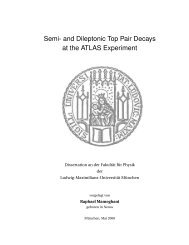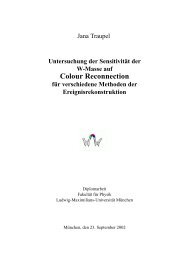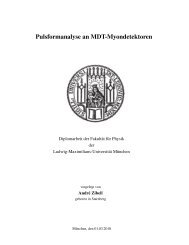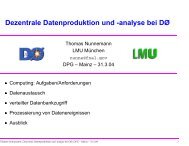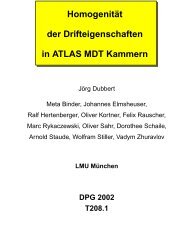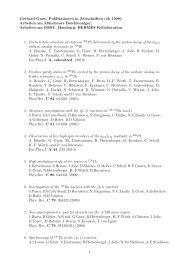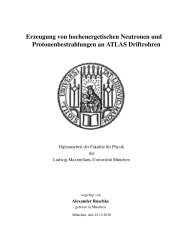development of micro-pattern gaseous detectors – gem - LMU
development of micro-pattern gaseous detectors – gem - LMU
development of micro-pattern gaseous detectors – gem - LMU
You also want an ePaper? Increase the reach of your titles
YUMPU automatically turns print PDFs into web optimized ePapers that Google loves.
Chapter 5<br />
Efficiency Determination<br />
This chapter addresses the efficiency <strong>of</strong> prototype 1.0. Since the trigger scintillators cover a larger<br />
area than the active size <strong>of</strong> the detector one has to correct for a geometrical factor which is presented<br />
in Ch. 5.1. The efficiency <strong>of</strong> prototype 1.0 equipped with an unsegmented anode is illustrated in Ch.<br />
5.2. With the installation <strong>of</strong> a flow and pressure control unit in the gas system as well as optimized<br />
operational voltage settings one obtains an optimized efficiency which is reported in Ch. 5.3.<br />
The efficiency ε is defined as the ratio <strong>of</strong> recorded signals S over the sum <strong>of</strong> all triggering events<br />
Stotal:<br />
5.1 Efficiency Simulation<br />
ε = S<br />
Stotal<br />
= Ndetected particles<br />
Ntotal particles<br />
The measurement <strong>of</strong> the efficiency is realized by two scalers (cf. Fig. 3.9). One <strong>of</strong> them counts the<br />
triple coincidence between detector and the two trigger scintillators, the other counts the two trigger<br />
scintillators alone. The threefold coincidence <strong>of</strong> scintillator triggers combined with the GEM’s signal<br />
is the real number <strong>of</strong> detected particles that are recorded by the FADC. Coincidence <strong>of</strong> the GEM<br />
surrounding scintillators gives the number <strong>of</strong> total particle that are crossing the active detection area.<br />
Since the surface <strong>of</strong> the two scintillators is about 40 % bigger than the <strong>detectors</strong> active area and taking<br />
their rectangular positioning into account, one has to correct the number <strong>of</strong> two-fold coincidences by<br />
the geometrical factor. A MonteCarlo Simulation is implemented to derive the real count rate <strong>of</strong><br />
particle traversing the active area <strong>of</strong> the GEM detector or scintillators.<br />
As illustrated in Fig. 5.1, the two scintillators are abstracted to rectangles, consisting <strong>of</strong> a lower and an<br />
upper plane. The GEM detector itself is represented by a simple plane, centered to the surface covered<br />
by both triggering <strong>detectors</strong>. For points placed in small equidistant steps on the lower and upper<br />
surface <strong>of</strong> Sc1 a large number <strong>of</strong> muons is simulated with incident directions defined by the angles θ<br />
and φ. It was assumed that the incident angles are distributed as f (θ) = cos 2 θ and normalized for<br />
the φ - coordinate via g(φ) = 1/2π. The values <strong>of</strong> the direction vector are transformed to Cartesian<br />
coordinates:<br />
direc[0] = cos(φ) sin(θ)<br />
direc[1] = sin(φ) sin(θ)<br />
direc[2] = cos(θ) .<br />
57<br />
(5.1)<br />
(5.2)



